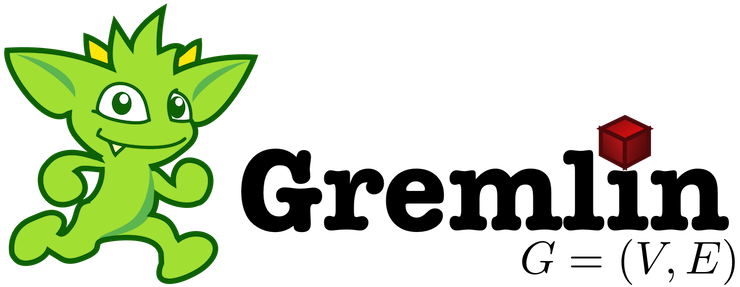6. Gremlin查询语言

Gremlin是JanusGraph的查询语言,用于从图中检索数据和更新数据。 Gremlin是一种面向路径的语言,它能够简洁地表示复杂的图形遍历和多步操作。 Gremlin是一种函数式语言,遍历运算被链接在一起形成类似路径的表达式。 例如,“从Hercules,遍历他的父亲,然后他父亲的父亲,并返回祖父的名字。”
Gremlin是Apache TinkerPop的一个组件。 它独立于JanusGraph开发,并且支持大多数的图数据库。 通过Gremlin查询语言在JanusGraph基础上开发的应用程序,用户可以避免被数据库绑定,因为他们的应用程序可以迁移到支持Gremlin的其他图数据库。
本节是Gremlin查询语言的简要概述。 有关Gremlin的更多信息,请参阅以下资源:
- Complete Gremlin Manual: Gremlin的参考手册。
- Gremlin Console Tutorial: 学习如何有效地使用Gremlin控制台以交互方式遍历和分析图形。
- Practical Gremlin Book: 图数据库和Gremlin查询语言的入门指南。
- Gremlin Recipes: Gremlin的最佳实践和常见遍历模式的集合。
- Gremlin Language Drivers: 使用不同的编程语言连接到Gremlin服务器,包括Go,JavaScript,.NET / C#,PHP,Python,Ruby,Scala和TypeScript。
- Gremlin Language Variants: 学习如何在编程语言中嵌入Gremlin。
- Gremlin for SQL developers: 使用SQL查询数据的方式来学习Gremlin。
1. 遍历介绍
Gremlin查询是一系列从左到右的计算操作/函数。 下面通过第3章“入门”中讨论的Gods图来展示一个简单的祖父查询的示例。
1 | g.V().has('name', hercules').out('father').out('father').values('name') |
上面查询的解读:
- g:当前图的遍历句柄。
- V:图中所有的顶点。
- has(‘name’, ‘hercules’):过滤出顶点name为hercules的顶点。
- out(‘father’):从hercules顶点遍历出边为father的边。
- out(‘father’):从hercules的father顶点遍历出边为father的边。
- name:获取hercules祖父顶点的name属性的值。
总之,这些步骤构成了类似路径的遍历查询。 每个步骤都可以分解并显示其结果。 在构建更大,更复杂的查询时,这种构建遍历/查询的方式很有用。
1 | g |
对于正确性检查,通常可以查看每个返回值的属性值,而不是查看他们的id。
1 | g.V().has('name', 'hercules').values('name') |
注意相关的遍历,展示了Hercules的整个父系树分支。 提供这种更复杂的遍历以展示语言的灵活性和可读性。 对Gremlin的有效掌握为JanusGraph用户提供了快速查询底层图结构遍历的能力。
1 | g.V().has('name', 'hercules').repeat(out('father')).emit().values('name') |
下面提供了一些遍历示例。
1 | hercules = g.V().has('name', 'hercules').next() |
每一步(由分隔表示)是对上一步计算出的对象进行操作的函数。 Gremlin语言中有许多步(参见Gremlin Steps)。 通过简单地改变步骤或着改变步骤的顺序,可以实现不同的遍历。 下面的例子返回所有与Hercules战斗相同怪物的人的名字,并且除去Hercules本身(即“共同战士”或者“盟友”)。
鉴于神的图形只有一个战斗者(Hercules),另一个战斗者(为了举例)被添加到图中,Gremlin展示了如何将顶点和边添加到图形中。
1 | theseus = graph.addVertex('human') |
添加顶点时,可以选择是否指定顶点标签。 但是添加边时必须指定边标签。 可以在顶点和边上设置作为键值对的属性。 使用SET或LIST基数定义的属性键,必须使用addProperty向顶点添加此属性。
1 | g.V(hercules).as('h').out('battled').in('battled').where(neq('h')).values('name') |
上面的例子有4个链接函数:out,in,except和values(即name是值的简写(’name’))。 每个的函数在下面逐条列出,其中V是顶点而U是任何对象,其中V是U的子集。
- out: V -> V
- in: V -> V
- except: U -> U
- values: V -> U
将函数链接在一起时,传入类型必须与传出类型匹配,其中U匹配任何内容。 因此,上面的“共同战斗/盟友”遍历是正确的。
注意:本节中介绍的Gremlin概述重点介绍了在Gremlin控制台中Gremlin-Groovy语言实现版本的使用。 Gremlin的其他语言驱动和实现也是可以使用的。
2. 遍历迭代
Gremlin控制台其中的一个特性是它从gremlin>prompt自动迭代所有的查询结果。 这在REPL环境中很好用,而且它将结果作为String类型来展示。 当你开始编写Gremlin应用程序时,了解如何显式迭代遍历非常重要,因为应用程序的遍历不会自动迭代。 以下是迭代遍历的一些常用方法:
- iterate() - 预期或者可以忽略空值。
- next() - 获取一个结果,一定要先通过hasNext()判断。
- next(int n) - 获取第n个结果,一定要先通过hasNext()判断。
- toList() - 获取所有的结果作为一个list,如果没有结果则返回空列表。
下面使用Java代码示例来演示这些概念:
1 | Traversal t = g.V().has("name", "pluto"); // Define a traversal |
欢迎扫码关注公众号,更好的交流

原文作者: xiuxiuing
原文链接: https://xiuxiuing.gitee.io/blog/2018/12/05/jggremlin/
许可协议: 知识共享署名-非商业性使用 4.0 国际许可协议